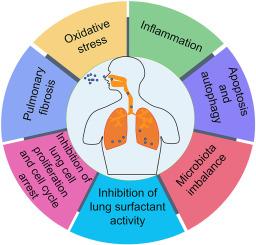微塑料对肺的危害及其毒理学机制
IF 7.3
2区 环境科学与生态学
Q1 ENVIRONMENTAL SCIENCES
引用次数: 0
摘要
微塑料作为无处不在的环境污染物,通过吸入对肺部健康构成重大风险。由于其体积小、表面积大、渗透性高,MPs在进入气道后逃避呼吸清除机制,沉积在肺部,引发一系列多方面的毒理学效应。根据大量的研究,本文总结了MPs诱导肺损伤的八个关键机制,包括:(1)氧化应激:MPs促进活性氧(ROS)的产生,破坏肺抗氧化防御,破坏细胞大分子;(2)炎症反应:MPs诱导炎症细胞浸润,上调促炎细胞因子(如IL-6、TNF-α),导致肺部炎症;(3)凋亡和自噬:MPs触发肺细胞凋亡和自噬,两者相互作用加重肺组织损伤;(4)微生物生态失调:MPs改变肺部微生物群,加重免疫功能障碍;(5)肺表面活性物质抑制:MPs吸附肺表面活性物质的蛋白质和其他成分,损害肺泡结构和功能;(6)抑制细胞增殖:MPs阻碍肺细胞修复,加重组织损伤;(7)肺纤维化:慢性MPs暴露诱导上皮-间质转化(EMT),促进胶原沉积和瘢痕形成;(8)协同毒性:MPs吸附共污染物(如重金属),放大肺损伤。长时间接触多磺酸粘多糖与尘肺病、哮喘和肺癌有关。尽管对MPs对肺损伤的机制有了深入的了解,但长期暴露于MPs对肺部疾病的影响和确切机制尚不清楚,对其原因的进一步研究需要时间。本文章由计算机程序翻译,如有差异,请以英文原文为准。


Lung hazards of microplastics and their toxicological mechanisms
Microplastics (MPs), as ubiquitous environmental pollutants, pose significant risks to pulmonary health through inhalation exposure. Due to their small size, large surface area, and high permeability, MPs evade respiratory clearance mechanisms upon entering the airways and deposit in the lungs, triggering a range of multifaceted toxicological effects. Drawing upon extensive research, this review summarizes eight key mechanisms by which MPs induce lung injury including (1) Oxidative stress: MPs promote the generation of reactive oxygen species (ROS), disrupting pulmonary antioxidant defenses and damaging cellular macromolecules; (2) Inflammatory response: MPs induce inflammatory cell infiltration and upregulate pro-inflammatory cytokines (e.g., IL-6, TNF-α), leading to pulmonary inflammation; (3) Apoptosis and autophagy: MPs trigger apoptosis and autophagy in lung cells, with their interplay exacerbating pulmonary tissue damage; (4) Microbial dysbiosis: MPs alter the lung microbiota, aggravating immune dysfunction; (5) Lung surfactant inhibition: MPs adsorb proteins and other components of lung surfactant, impairing alveolar structure and function; (6) Suppressed cell proliferation: MPs hinder lung cell repair, worsening tissue injury; (7) Pulmonary fibrosis: chronic MPs exposure induces epithelial-mesenchymal transition (EMT), promoting collagen deposition and scar formation; (8) Synergistic toxicity: MPs adsorb co-pollutants (e.g., heavy metals), amplifying lung injury. Prolonged MPs exposure is associated with pneumoconiosis, asthma, and lung cancer. Despite the insights gained into the mechanisms of MPs on lung injury, the effects and exact mechanisms of long-term exposure to MPs on lung disease remain unclear, and further research into their causes is the need of time.
求助全文
通过发布文献求助,成功后即可免费获取论文全文。
去求助
来源期刊

Environmental Pollution
环境科学-环境科学
CiteScore
16.00
自引率
6.70%
发文量
2082
审稿时长
2.9 months
期刊介绍:
Environmental Pollution is an international peer-reviewed journal that publishes high-quality research papers and review articles covering all aspects of environmental pollution and its impacts on ecosystems and human health.
Subject areas include, but are not limited to:
• Sources and occurrences of pollutants that are clearly defined and measured in environmental compartments, food and food-related items, and human bodies;
• Interlinks between contaminant exposure and biological, ecological, and human health effects, including those of climate change;
• Contaminants of emerging concerns (including but not limited to antibiotic resistant microorganisms or genes, microplastics/nanoplastics, electronic wastes, light, and noise) and/or their biological, ecological, or human health effects;
• Laboratory and field studies on the remediation/mitigation of environmental pollution via new techniques and with clear links to biological, ecological, or human health effects;
• Modeling of pollution processes, patterns, or trends that is of clear environmental and/or human health interest;
• New techniques that measure and examine environmental occurrences, transport, behavior, and effects of pollutants within the environment or the laboratory, provided that they can be clearly used to address problems within regional or global environmental compartments.
 求助内容:
求助内容: 应助结果提醒方式:
应助结果提醒方式:


